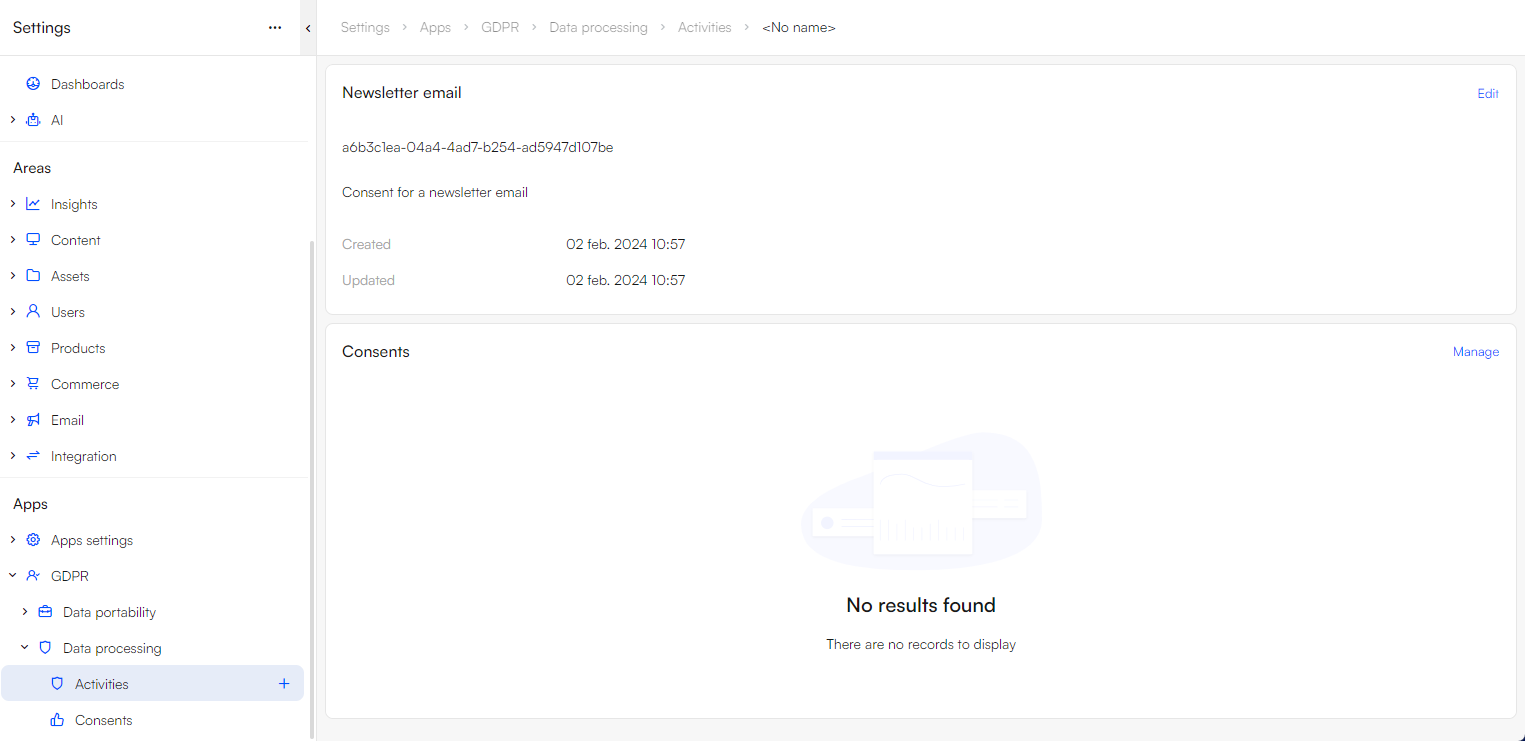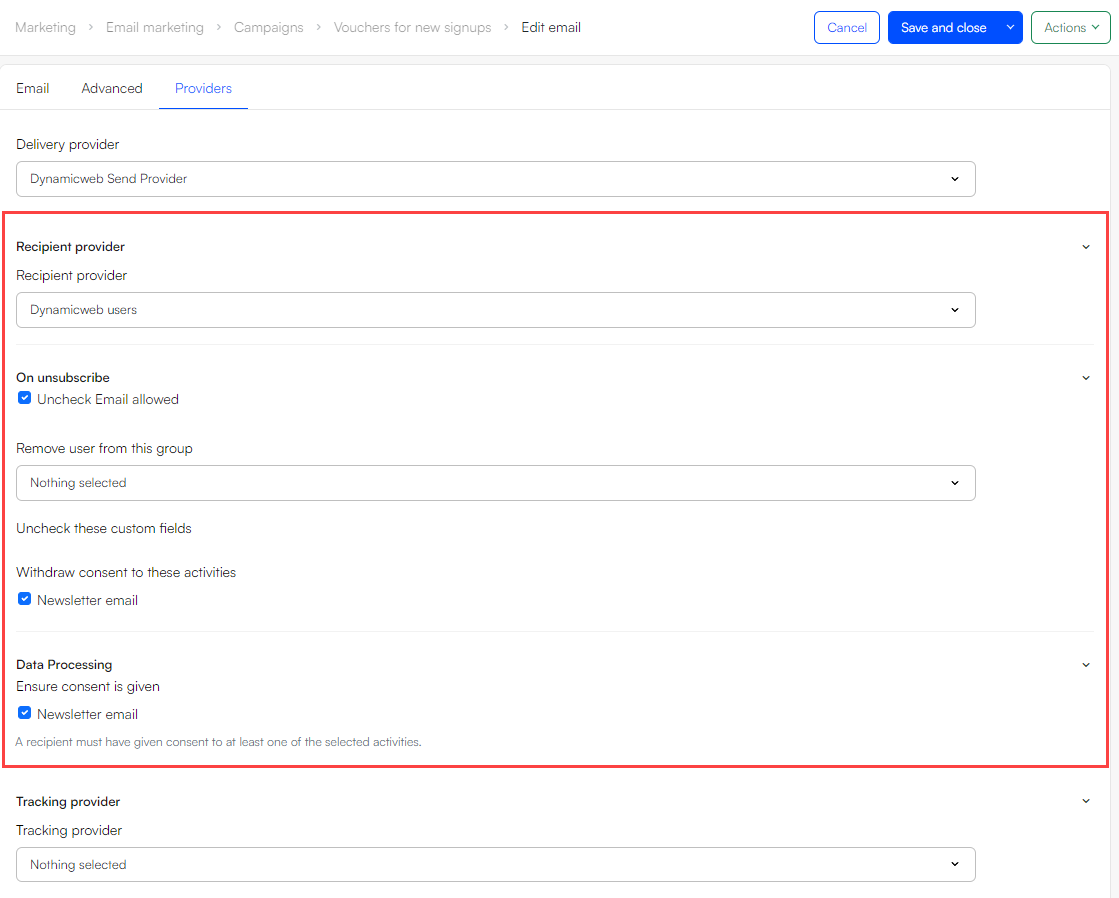Data Processing
Access for users and visitors to give or withdraw consents to some activities
The Data Processing app allows you to create activities and collect consents, in order to comply with the General Data Protection Regulation (GDPR) which was adopted in April 2016 and became enforceable on May 25th 2018.
With the Data Processing app you can:
- Create Activities – e.g. Newsletter Consent
- View Consents collected from the Extranet app and the Forms for Editors app
Activities
An activity is a convenient way of creating clear, concise and granular opt-in categories. Activities will always be specific to your business and data flow.
To create an activity:
- Go to Settings, and from the node GDPR choose Data Processing
- Go to Activities and click New activity
- Enter a Name and a Description
- Click Save and close
Once an activity has been created, you can click it and edit or view the activity details. You can see:
- The activity ID
- The Name and Description
- When the activity was created and updated
- A list of consents received for this activity with the most essential consent information

Note
Please note, that a user gives consent to a particular activity as it is worded at the time of consent. If you edit the name or the description of an activity afterwards, their consents are no longer valid. So unless you are correcting a simple spelling mistake, we advise you to start over and create a new consent every time.
Consents
Once you have one or more activities defined, you can start collecting consents.
For each consent, the following must be registered:
- Who gave consent
- What they consented to
- How they consented (e.g. via website form, on phone, via email, etc.)
- When they consented or withdrew consent
Consequently, for each consent we register the following:
| Field | Values | Comment |
|---|---|---|
| Activity ID | The ID of an activity in the Data Processing app | |
| Subject ID | AccessUser ID/email/checksum | For logged in users, this is their AccessUser ID. For anonymous users it is either an email (if we know it, from e.g. a form) or a checksum if we don’t. |
| Subject Type | User/email/Visitor | Logged in users have User, anonymous users where we know the email have Email, and a truly anonymous users have Visitor |
| Status | Given/Withdrawn | |
| Request user host address | An IP address | |
| Request user agent | User agent details | |
| Created date | Date & Time | |
| Updated date | Date & Time | |
| Checksum | Checksum value |
Consents can be browsed when clicking on the Consents view in the Data Processing app's area tree. You can also view consents for a specific activity by opening that activity, as described above.
Obtaining consents
Consents can be collected from the following places:
- The Forms for Editors app when submitting a form
- The Extranet app when creating or editing a user
In short, each app instance can be associated with a consent activity – and when the user is edited/created or submits a form, the consent is then saved to the consent lists described above.
Using consents
At present, the Consents which are stored and managed using the Data Processing app are only used in Email.
To automatically check for consents when sending emails using the Email tool:
- Create an email
- Switch to the Providers tab
- Select Dynamicweb Users in the Recipient Provider dropdown menu
- In the On unsubscribe and Data Processing section, select the appropriate consent activity

Listing & managing consents in frontend
In frontend, logged-in users can manage their consents via the Extranet app. Use the Consents loop to iterate through the relevant data:
- In the View mode the user can access a list of all available consent activities and see which consent activities they have agreed to
- In the Edit mode the user can access a list of all available consent activities and give or withdraw consent for each consent activity
- You do so by including input fields to the edit profile form. The input names must have the "Consent_" prefix followed by the activity id. The value of each input should be "true" (consent given) or "false" (consent withdrawn)
For advanced scenarios you can make use of @Consents in your razor templates. This will give you an instance of ConsentManager which provides a number of methods for managing consents.